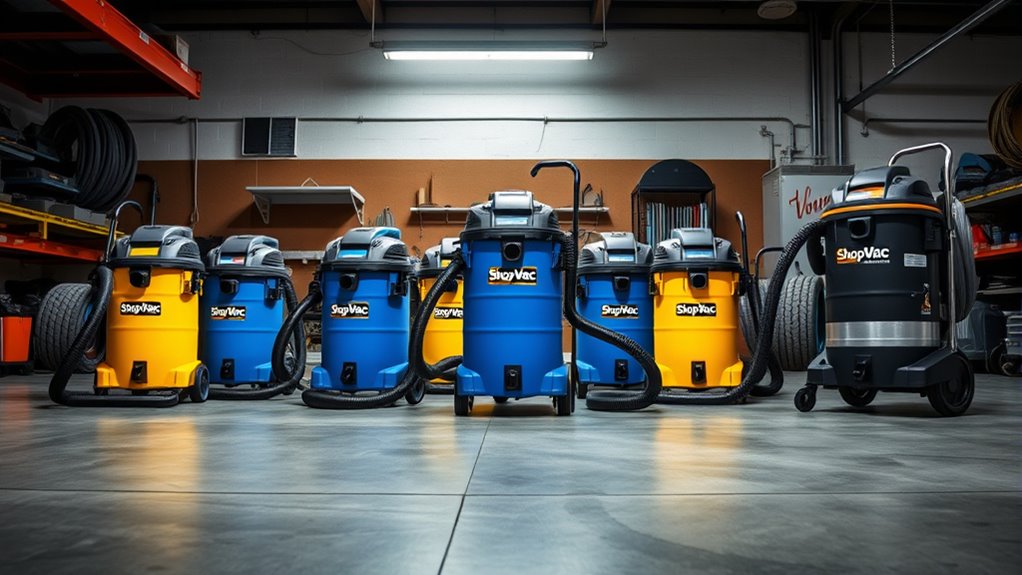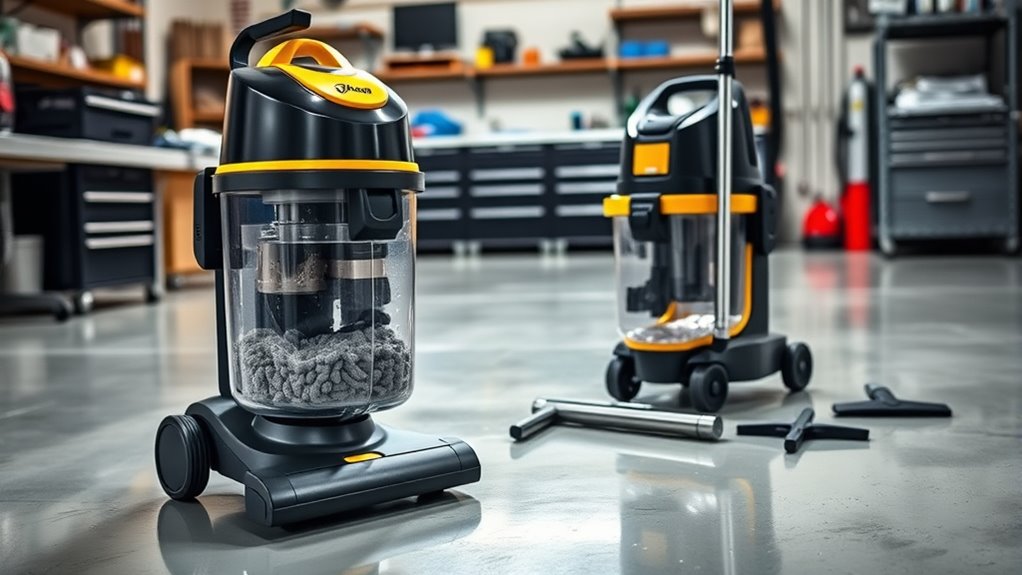Shop vacs and wet/dry vacuums are versatile tools that let you clean up both liquids and dry debris easily. They come in various sizes and power levels, with features like durable tanks and specialized attachments for different jobs. Proper maintenance and storage make sure they last longer and work efficiently. If you want to learn how to choose, maintain, and use them effectively, you’ll find helpful tips and insights as you continue exploring.
Key Takeaways
- Shop vacs handle both wet and dry messes, suitable for various environments like workshops and construction sites.
- Industrial-grade models feature powerful motors, durable materials, and large tanks for heavy-duty cleaning.
- Regular maintenance includes emptying tanks, cleaning filters, inspecting hoses, and ensuring motor vents are clear.
- Proper storage involves keeping the vacuum in a dry, temperature-controlled area and storing attachments carefully.
- Troubleshoot issues by checking cords, clearing blockages, and understanding safety features like thermal cutoffs.

Are you looking for a versatile cleaning tool that can handle both wet and dry messes with ease? A shop vac or wet/dry vacuum might be just what you need. These machines are designed to tackle a variety of cleaning tasks, from drywall dust and sawdust to spilled liquids and debris. When choosing one, it’s important to consider the industrial features that set apart professional-grade models from basic household vacuums. Industrial features include powerful motors, durable construction, and large-capacity tanks that allow you to clean longer without frequent emptying. These features guarantee the vacuum can endure heavy-duty use and handle tougher messes efficiently. Plus, they often come with specialized attachments and filters suited for different environments, whether in a workshop, construction site, or industrial setting.
Maintaining your shop vac properly is essential to keeping it running at peak performance. Regular maintenance tips include emptying the tank before it reaches maximum capacity to prevent strain on the motor and to avoid loss of suction. Cleaning or replacing filters regularly guarantees the best airflow and prevents dust and debris from clogging the system. For models with HEPA filters, check manufacturer recommendations on replacement intervals to maintain air quality and filtration efficiency. Inspect hoses and attachments for cracks or damage, replacing them as needed to prevent leaks and guarantee consistent suction power. Additionally, keep the motor vents clear of dust and debris, as blockages can cause overheating and reduce lifespan. Proper storage is also necessary; store your vacuum in a dry, clean area and avoid exposing it to extreme temperatures, which can damage internal components.
When it comes to troubleshooting, understanding the industrial features can help you diagnose common issues. For example, if your vacuum isn’t starting, check the power cord and switch connections first. If suction is weak, look for clogs or blockages in the hose or filters. Many models include safety features like thermal cutoffs or overload protection, which can trip if the motor overheats or the unit is overfilled. In such cases, allow the vacuum to cool down and clear out debris before restarting. Investing in a model with user-friendly maintenance features, such as easily accessible filters and tanks, makes upkeep more straightforward. Remember, following the manufacturer’s maintenance tips and understanding the industrial features of your vacuum will extend its lifespan and enhance its cleaning efficiency, guaranteeing you get the most value from your investment over time.
Frequently Asked Questions
Can Shop Vacs Handle Hazardous Materials Safely?
You might wonder if shop vacs can handle hazardous materials safely. While some wet/dry vacuums are equipped for hazardous material handling, not all are designed for this purpose. Always check safety precautions, like using proper filters and PPE, before attempting to clean hazardous substances. If unsure, choose a vacuum specifically rated for hazardous materials, ensuring your safety and effective cleanup. Never compromise safety for convenience.
What Is the Best Maintenance Routine for Wet/Dry Vacuums?
Maintaining your wet/dry vacuum maximizes its performance and prolongs its life. Follow a simple routine: regularly replace filters to guarantee ideal filtration, and clean out debris after each use. Store your vacuum in a dry, cool place to prevent damage, and check hoses for blockages. This consistent care keeps your vacuum ready and reliable, making cleanup quick, easy, and efficient every time.
Are There Specific Filters for Different Debris Types?
You should know that there are debris-specific filters designed for different types of debris. Filter compatibility is vital to guarantee your vacuum handles messes efficiently. For example, fine dust needs a HEPA filter, while larger debris may require a more robust, heavy-duty filter. Always check your wet/dry vacuum’s specifications to choose the right filter type, so your device functions at its best and lasts longer.
How Do I Choose a Vacuum for Delicate Surfaces?
Did you know that using the wrong vacuum can damage delicate surfaces? When choosing a vacuum for delicate surface cleaning, focus on vacuum material compatibility. Look for models with adjustable suction power and soft brush attachments to prevent scratches or marks. You should also select vacuums labeled specifically for delicate surfaces, ensuring gentle yet effective cleaning without compromising the surface’s integrity. This approach keeps your surfaces pristine and damage-free.
Can Shop Vacs Be Used for Water Extraction in Floods?
Yes, you can use a shop vac for flood cleanup and water extraction. They’re designed to handle wet messes and can efficiently remove excess water from flooded areas. Just make sure the shop vac is rated for water pickup, and empty it frequently to prevent overflow. Using a shop vac for water extraction is a practical solution to dry out your space quickly and effectively during flood emergencies.
Conclusion
Now that you know the ins and outs of shop vacs and wet/dry vacuums, you’re ready to tackle any cleanup mission like a modern-day MacGyver. Whether you’re dealing with a DIY project or an unexpected spill, these versatile tools are your trusty sidekicks. Don’t forget, even in a world of smart gadgets, a good shop vac can still save the day faster than a knight riding a mechanical steed. Happy cleaning!









